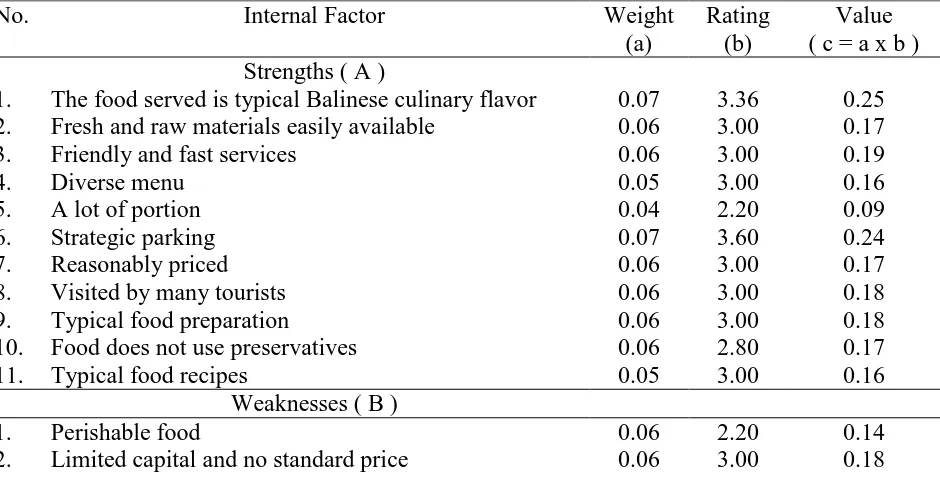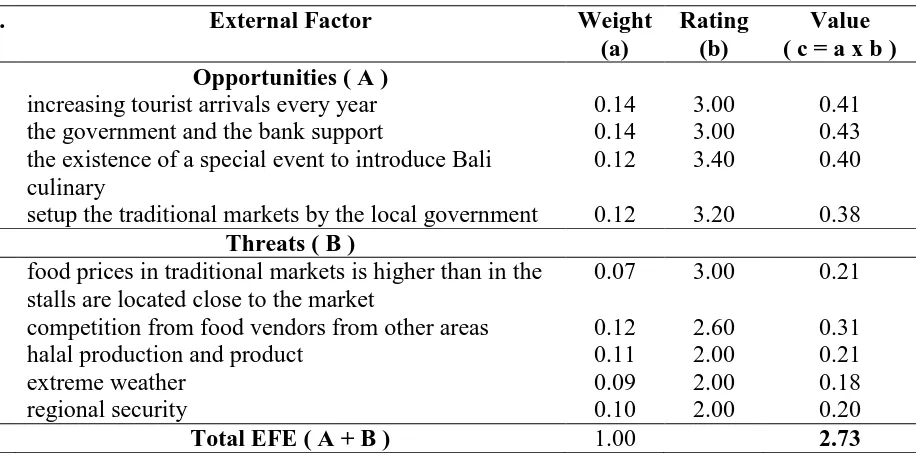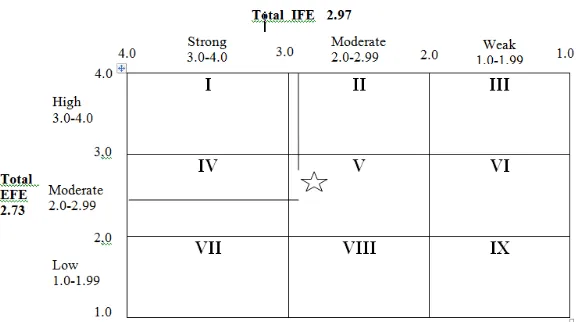The 16th FOOD INNOVATION ASIA CONFERENCE 2014
12 -13 June 2014
BITEC Bangna, Bangkok, Thailand
Development of Traditional Food at Traditional Market as a Culinary
Tourism Products (Case Study at Bali Province)
Luh Putu Wrasiati1*, Anak Agung Putu Agung Suryawan Wiranata1, I Made Anom
Sutrisna Wijaya2
1 Department of Agro-industrial Technology, Faculty of Agricultural Technology, Udayana University
2 Department of Agricultural Engineering, Faculty of Agricultural Technology, Udayana University.
* Corresponding author: wrasiati@gmail.com
Abstract
Traditional food is served in the traditional market and a product of culinary tourism in Bali has not been well managed and developed. Types of food or beverages, the appearance of product information, display, presentation, packaging, taste, price,
cleanliness, use of dyes and preservatives need special attention. Therefore, it’s
necessary to build a strategy to develop traditional food into unique culinary tourism product, tasty, healthy, and safe to eat. The method used in this study is a Strengths-Weaknesses-Opportunities-Threats (SWOT) analysis. Related data on Internal Factor Evaluation (IFE) matrix, External Factor Evaluation (EFE) matrix, and the Internal External (IE) matrix was obtained by in-depth interviews with traders, consumers, market managers. Phase of weighting, rating, and matching, were done by experts in the field of traditional food, tourism experts and relevant agencies in the province of Bali. The result
showed that the IFE value is 2.97. The IFE value was plotted on x–axis of Internal
External matrix. The EFE value is 2.73, and plotted on y-axis of Internal-External matrix. This suggested that the development of traditional food in traditional markets was based on IE matrix located on the cell five (V). Division in cell V can be managed
with a strategy Hold and Maintain. Market expansion and product development strategies
are the two most carried to the types of this division. Market expansion strategies for traditional food can be carried out by providing an opportunity for food entrepreneurs to develop their business in traditional markets that located close to tourist destinations such
as Tanah Lot, Tampak Siring, Uluwatu, Tanjung Benua, Lovina, Ubud, Kintamani, and
other areas. Product development strategy can be performed by applying the appropriate technology, preservation technology, improving the attractiveness and hygienic of the food product, providing product menus with a clear picture and price, and the cleanliness and attractiveness of the seller.
The 16th FOOD INNOVATION ASIA CONFERENCE 2014
12 -13 June 2014
BITEC Bangna, Bangkok, Thailand
Introduction
Traditional foods have played a major role in traditions of different cultures and
regions for thousands of years. They include foods that have been consumed locally and
regionally for an extended time period. Preparation methods of traditional foods are part
of the folklore of a country or a region. Most people can probably name at least one
traditional food of the region where they come from. There are very few definitions
available, and most of them have been developed relatively recently (Weichselbaum et
al., 2009). Traditional food is part of physiological characteristics (hygienic and
nutritional values), psycho-sensorial, social, and symbolic environment (Bessiere, 1998).
Fischler (1993) in Bessiere (1998) showed that eating the traditional food has a double meaning, ―the eater becomes what the consumers‖ and ―the eater becomes part of the
culture‖.
In Bali province, traditional food is closely associated with the Hindu culture, and
is still used widely by the people and is known as the culinary culture of Bali. Culinary
culture is an integral starting from the raw materials, processing, packaging and manner
of presentation of the food. Traditional food products and consumption procedures were
developed to be an alternative travel culinary tour of Bali, namely Bali culinary tourism.
Culinary products not only display the "typical food" but can develop into a media
interpretation broaden travelers (Virna, 2007).
The government of Bali Province provides special places for culinary tourism
destination. Gianyar regency began managing its traditional markets in such a way that it
becomes a culinary tourism destination for domestic and foreign tourists, Badung regency
manage their coastal areas (Jimbaran) into a culinary seafood, and Denpasar Government
has begun to resemble a traditional Balinese cuisine through food heritage festival held
every end of the year in the city center. Meanwhile, some traditional markets in other
districts such as Tabanan, Bangli and Klungkung has not been managed well as a culinary
The 16th FOOD INNOVATION ASIA CONFERENCE 2014
12 -13 June 2014
BITEC Bangna, Bangkok, Thailand
Traditional food was served as a culinary tourism product in Bali has not been
maintained and developed. Types of food or beverages were sold, and the appearance of
product information, display, presentation, packaging, taste, price, cleanliness, use of
dyes and preservatives needs special attention. Therefore, strategies are needed to
develop the traditional food into unique culinary tourism product, tasty, healthy, and safe
to eat. Research conducted by Wrasiati et al. (2007) states that the traditional food found
in traditional markets was detected containing hazardous substances such as rodhamin B
(dyes), borax, formalin, and saccharin were over the limit for safe consumption of food
products.
Materials and Methods
Research Material
Materials used in this study were types of traditional foods sold at traditional
markets in the province of Bali, seminar kit, stationary, calculators, digital camera, flash
disk, and external disk.
Research Method
This research was conducted in traditional markets which serves traditional food in
all districts/cities in the province of Bali. The research subjects were selected using
purposive sampling method, namely the stakeholders associated with the development of
traditional food and culinary tourism in Bali, which includes (i) the traditional market
traders, (ii) market committee (iii) Department of Tourism, (iv) the Department of
Commerce, (v ) Department of Culture, (vi) the travel agency, (vii) the decision makers
in the traditional market area concerned, and (viii) the consumer or a tourist in the
traditional market. The method used to obtain the data of the research subjects are
observation, in-depth interviews, questionnaires, and documentation studies. Data were
analyzed using the SWOT (Strengths-Weaknesses-Opportunities-Threats) analysis. In
The 16th FOOD INNOVATION ASIA CONFERENCE 2014
12 -13 June 2014
BITEC Bangna, Bangkok, Thailand
information; (2) set up the expert group; (3) identifying internal and external strategic
factors; (4) forming Internal Factor Evaluation (IFE) and External Factor Evaluation
(EFE) matrix to evaluating the internal and external factors; and (5) forming SWOT
matrix and developing strategy.
At first, the organization’s (traditional market traders) vision and mission
statement are determined. Internal and external environments of the organization are
analyzed and the obtained information specifies opportunities and threats (external
factors) and strengths and weaknesses (internal factors). Then, using SWOT matrix, the organizations’ strengths, weaknesses, opportunities and threats are evaluated. The SWOT matrix is commonly used to systematically analyze internal and external environment of
organizations (Kangas et al, 2003). Terrados et al. (2007) considered it as an effective
instrument for identifying the problems and drawing lines of future actions. Finally, the
expert group makes the weighing, rating and matching for IFE and EFE matrix, and then
they make some strategies in SWOT matrix base on the IFE and EFE matrix. Finally,
decision-making stage and using different types of matrix including external factor
evaluation matrix (EFE), internal factor evaluation matrix (IFE), SWOT matrix and
strategic position matrix (David, 2011). The expert group in this reseaarch consisted of 3
people, namely researchers in the field of traditional foods, decision makers in the
department of tourism, and decision makers in the traditional market.
Result and Discussion
Traditional Market in the Province of Bali
In Bali province, there are 20 traditional markets that operated in the afternoon until
night, which is known as pasar senggol. These markets serve traditional Balinese food
and is planned to be developed into a culinary tourism destination. From the 20
traditional markets surveyed, there are four markets namely Senggol Kota Tabanan,
Kreneng Asoka-Denpasar, Senggol Kota Gianyar, dan Senggol Kota Klungkung has been
The 16th FOOD INNOVATION ASIA CONFERENCE 2014
12 -13 June 2014
BITEC Bangna, Bangkok, Thailand
traditional markets that are commonly visited by domestic and foreign tourists, both
personally and group namely Senggol Kuta I and II, Senggol Nusa Dua, Senggol
Sukawati Gianyar, and Senggol Taman Kota Singaraja.
Internal and External Factors of Culinary Tourism in Traditional Markets
The internal factors consist of strengths and weaknesses. From the results of the
surveys and interviews conducted to merchants, consumers, and policy makers in the
traditional market, the strength of the traditional market that serve traditional food are the
food served is typical Balinese culinary flavor, fresh and raw materials easily available,
friendly and fast services, diverse menu, a lot of portion, strategic parking, reasonably
priced, visited by many tourists, typical food preparation, food does not use preservatives,
and typical food recipes. The weaknesses of the traditional market that serve traditional
food are perishable food, limited capital and no standard price, less clean washrooms,
waiters and traders do not use the apron and head covering, presentation of the food was
not covered, and the availability of electricity and clean water is limited.
The external factors consist of opportunities and threats. From the results of surveys
and interviews conducted to merchants, consumers, and policy makers in the traditional
market, the opportunities are increasing tourist arrivals every year, the government and
the bank support, the existence of a special event to introduce Bali culinary and setup the
traditional markets by the local government. The threats of the traditional market that
serve traditional food are food prices in traditional markets is higher than in the stalls are
located close to the market, competition from food vendors from other areas, halal
production and product, extreme weather, and regional security.
The results of the internal and external weighting factors based on in-depth
interviews with experts found that the average weight for an internal factor is 65.80 and
the average weight for an external factor is 33.80. Internal factors have a greater average
weight (nearly two times greater) than the average weight for external factors. This
means that there are factors within the organization such as vendors, market managers,
The 16th FOOD INNOVATION ASIA CONFERENCE 2014
12 -13 June 2014
BITEC Bangna, Bangkok, Thailand
traditional markets, so that, strategy is aimed at maintaining the existing strengths and
mitigate or overcome weaknesses.
The result of the calculations for the average rating is 50.00 internal factors and an
external factor is 24.20. This calculation shows the same thing with an average weight of
internal and external factors. Internal factors have a greater average weight (two times
greater) than the average weight for external factors. The average rating and weight are
the basis for the calculation of the IFE and EFE matrix.
IFE and EFE Matrix Analysis of Culinary Tourism in Traditional Markets
Internal External Matrix (IE) is used to formulate a strategy that will be used to
develop culinary tourism business. The value of the X and Y axis is obtained by
multiplying the weight and rating for each element strengths, weaknesses, the
opportunities and threats. EFE total weighted value on the vertical axis (y-axis) and total
weighted score of IFE on the horizontal axis (x-axis) are presented in Table 1 and 2, and
the strategy are illustrated in Figure 1.
Table 1 Internal Factor Evaluation Matrix
No. Internal Factor Weight
(a)
1. The food served is typical Balinese culinary flavor 0.07 3.36 0.25
2. Fresh and raw materials easily available 0.06 3.00 0.17
The 16th FOOD INNOVATION ASIA CONFERENCE 2014
6 The availability of electricity and clean water is
limited
0.05 2.60 0.13
Total IFE ( A + B ) 1.00 2.97
Based on the mapping of the IE matrix, it can be seen that the x-axis of the IE
Matrix, the IFE is the total value of 2.97, while the y-axis matrix IE, EFE total value is
2.73. This suggests that the strategy of development of traditional food in traditional
Balinese province located on the cell V. Division in cell V can be managed with a
strategy Hold and Maintain. Market expansion and product development strategies are
the two most carried to the types of the division. According Rangkuti (2006), cell V is the
concentration strategy on horizontal integration or stability.
Table 2 External Factor Evaluation Matrix
No. External Factor Weight
(a)
1. increasing tourist arrivals every year 0.14 3.00 0.41
2. the government and the bank support 0.14 3.00 0.43
3. the existence of a special event to introduce Bali
culinary
0.12 3.40 0.40
4 setup the traditional markets by the local government 0.12 3.20 0.38
Threats ( B )
1. food prices in traditional markets is higher than in the
stalls are located close to the market
0.07 3.00 0.21
2. competition from food vendors from other areas 0.12 2.60 0.31
3. halal production and product 0.11 2.00 0.21
4. extreme weather 0.09 2.00 0.18
5. regional security 0.10 2.00 0.20
Total EFE ( A + B ) 1.00 2.73
Market expansion strategies for traditional food can be done by providing an opportunity
The 16th FOOD INNOVATION ASIA CONFERENCE 2014
12 -13 June 2014
BITEC Bangna, Bangkok, Thailand
tourist destinations such as the market in the area of Tanah Lot, Tampak Siring, Uluwatu,
Tanjung Benua, Lovina, Ubud, Kintamani, and other areas as well as the use of online
marketing. Product development can be done by creating a new menu variety,
presentation products and stores more attractive and hygienic, the availability of a list of
menus with pictures and clear pricing, making brochures, and appearance sellers are
clean, neat and attractive. A new menu is creating by modifying ingredient and varies the
seasonings to improve the taste.
Figure 1 Internal External (IE) Matrix
SWOT Analysis and Strategies
SWOT analysis and strategies is presented in Table 3. SWOT analysis should not only result the identification of a corporation’s distinctive competencies-the particular capabilities and resources that a firm possesses and the superior way in which they are
used, but also in the identification of opportunities that the firm is not currently able to
take an advantage of due to a lack of appropriate resources (Wheelen and David, 2010).
David (2011) states, there are four strategies are decided by the experts to develop
traditional food products in the traditional markets of Bali Province. The strategy is SO
(Strength Opportunities: Use strengths to the pick-up opportunities), WO (Weaknesses
The 16th FOOD INNOVATION ASIA CONFERENCE 2014
12 -13 June 2014
BITEC Bangna, Bangkok, Thailand
Threats: prevention of the negative effects of external threats using internal strengths),
and WT (Weakness Threats: Minimize weaknesses to avoid threats). After in-depth
interview discussions by experts, the traditional market developments as a tourist
destination in Bali culinary produce 8 strategies. Each strategy formulation consisting of
2 recommends strategies to be implemented in order to develop culinary tourism in the
traditional markets of Bali Province. The strategy can be implemented if there is good
networking between the merchants, the government, universities, and consumers (tourists
and travel agencies).
Table 4 SWOT Strategies
SO Strategies
1. Providing an opportunity for food entrepreneurs to develop their business in traditional markets that located close to tourist destinations
2. Promoting the market and traditional food products via brochures or leaflets in public places, and creating business agreements with travel agents and utilizing the web information
WO Strategies
1. Utilizing the support of the government and banks to capital, availability of clean water and electricity
2. To increase cleanliness and hygiene
ST Strategies
1. Providing complete list of menu with product prices
2. Providing information on the raw materials and processes of the food
WT Strategies
1. Implementing the production planning and production processes carefully 2. Applying preservation and packaging
technology to extend the shelf life of the product
Conclusion
Traditional product development as a culinary tour in the traditional market in
Bali province is based on two strategies: market expansion and product development.
Market expansion strategies for traditional food can be done by providing an opportunity
for food entrepreneurs to develop their business in traditional markets are located close to
The 16th FOOD INNOVATION ASIA CONFERENCE 2014
12 -13 June 2014
BITEC Bangna, Bangkok, Thailand
Tanjung Benua, Lovina, Ubud, Kintamani, and other areas, the promotion of products
with the brochure, and the use of online marketing. Product development can be done by
creating a new menu variety, presentation products and stores more attractive and
hygienic, the availability of a list of menus with clear images and prices, applying
preservation and packaging technology to extend the shelf life of the product and sellers
appearance that is clean, neat and attractive.
Acknowledgment
The autors would like to thank to the Directorate General of Higher Education,
Ministry of Education and Culture of the Republic of Indonesia, which has funded this
research on skim of Master Plan for the Acceleration and Expansion of Indonesian
Economic Development.
References
Bessiere, J. 1998. Local Development and Heritage : Traditional Food and Cuisine as
Tourists Attractions in Rural Areas. European Society for Rural Sociology 38
(1): 21-34
David, F.R. 2011.Strategic Management: Concepts and Cases.tPearson Education, Inc.,
Publishing, Prentice Hall, One Lake Street, Upper Saddle River, New Jersey
Kangas J, M. Kurttila , M. Pesonen , M. Kajanus , and A. Kangas. 2003. Evaluating the
Management Strategies of a Fforestland Estate—the S–O–S approach. Journal
of Environmental Managemen (69): 349–358.
Rangkuti, F, 2006. SWOT Analysis, Business Case Techniques Dissecting-Reorientation
Strategic Planning Concepts for Facing the 21st Century. Gramedia Pustaka
Utama. Jakarta.
Terrados, J., G. Almonacid, and L. Hontoria. 2007. Regional Energy Planning Through
SWOT Analysis and Strategic Planning Tools: Impact on Renewables
Development. Renewable & Sustainable Energy Reviews 11(6): 1275-1287.
The 16th FOOD INNOVATION ASIA CONFERENCE 2014
12 -13 June 2014
BITEC Bangna, Bangkok, Thailand
Weichselbaum , E., B. Benelam, and H.S. Costa. 2009. Traditional Foods in Europe.
EuroFIR, Portugal.
Wheelen, T. L. and H. J. David. 2010. Strategic Management and Business Policy:
Achieving Sustainability 12th Edition. Prentice Hall, Pearson Education Asia
Pte Ltd. New Jersey:
Wrasiati, L.P., A. Hartiati, and L. Suhendra. 2007. Quality Characteristics of Traditional
Snacks That served at Badung Market. Research Report, FTP, Udayana



